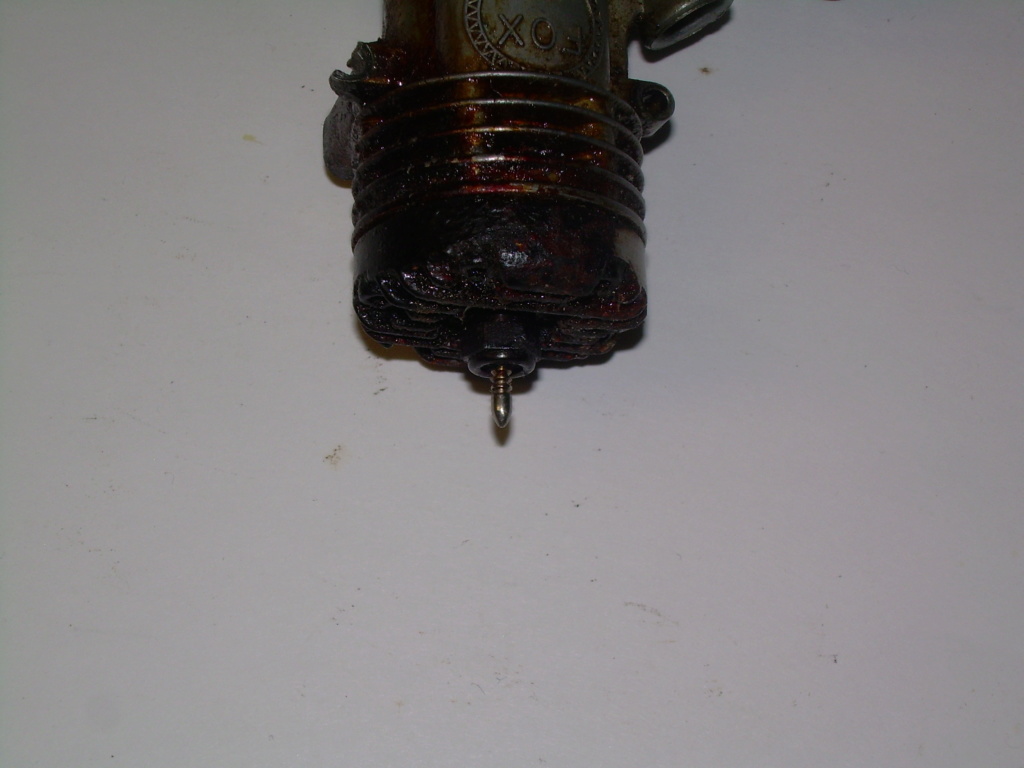Log in
Search
Latest topics
» Purchased the last of any bult engines from Ken Enyaby sosam117 Today at 10:25 am
» Free Flight Radio Assist
by rdw777 Today at 9:24 am
» My N-1R build log
by rdw777 Today at 9:17 am
» Funny what you find when you go looking
by rsv1cox Yesterday at 3:21 pm
» Landing-gear tips
by 1975 control line guy Yesterday at 8:17 am
» Cox NaBOO - Just in time for Halloween
by rsv1cox Tue Nov 19, 2024 6:35 pm
» Canada Post strike - We are still shipping :)
by Cox International Tue Nov 19, 2024 12:01 pm
» Duende V model from RC Model magazine 1983.
by getback Tue Nov 19, 2024 6:08 am
» My current avatar photo
by roddie Mon Nov 18, 2024 9:05 pm
» My latest doodle...
by TD ABUSER Mon Nov 18, 2024 11:30 am
» Brushless motors?
by rsv1cox Sun Nov 17, 2024 6:40 pm
» Tribute Shoestring build
by amurphy6812 Sun Nov 17, 2024 5:43 pm
Cox Engine of The Month
K&B .35 Stallion Acquisition
Page 3 of 4
Page 3 of 4 •  1, 2, 3, 4
1, 2, 3, 4 
 Re: K&B .35 Stallion Acquisition
Re: K&B .35 Stallion Acquisition
Why not a Fox .35 Pink Head?

ticomareado- Account Under Review
- Posts : 1089
Join date : 2013-10-03
Location : NC

Ken Cook- Top Poster

- Posts : 5635
Join date : 2012-03-27
Location : pennsylvania

GallopingGhostler- Top Poster


Posts : 5721
Join date : 2013-07-13
Age : 70
Location : Clovis NM or NFL KC Chiefs
 Re: K&B .35 Stallion Acquisition
Re: K&B .35 Stallion Acquisition
https://youtu.be/fDvo9ijDiZI
my Stallion 35 running on test bench
my Stallion 35 running on test bench
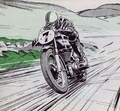
cstatman- Platinum Member



Posts : 568
Join date : 2021-02-17
Age : 60
Location : San Jose, CA
 Re: K&B .35 Stallion Acquisition
Re: K&B .35 Stallion Acquisition
The Stallion is a tough engine to find a plane for. It's weight being about 8.7 ounces makes it difficult for some choices. In addition, the run of the Stallion is unlike the competition of the time. It wants to run fast which is great for sport but can prove to be a bit of challenge with some planes. It suits better for short nosed planes such as a Flite Streak. While it would work on profiles such as Ringmasters and the likes, it's weight is a handicap. Most of these profiles already are designed on the premise of being nose heavy with lighter engines. I used to fly the Stallion on the Midwest 48" warbird series, while it wasn't the best it worked and it was good fun. Not exactly the quietest engine. Unfortunately, muffling this one is not a good recommendation. It will muffle it but it could also overheat it and in short order. One just needs to opt towards the richer side if done so and not let it get into a burn down run.
I've posted many points pros and cons on this engine over the past few years. I only see them run on a stand and never on a plane. The Stallion while it was intended to undermine the competition. It was never sold at or lower than the competition. My dad purchased his in "69". The box which I still have was marked $12.95 originally and scratched out with $11.95 as the final price. AHC hobby shop in New York was offering the engine at $9.95 in and around this year but you had to purchase the kit they were offering with it.
Used with the correct fuel, keep the nitro at 10% and common sense, the engine will last a long time. In my opinion it would outlast a Mccoy redhead. I've witnessed the redhead wear itself out on one run right before my eyes. Neat engine, get it on a plane.
I've posted many points pros and cons on this engine over the past few years. I only see them run on a stand and never on a plane. The Stallion while it was intended to undermine the competition. It was never sold at or lower than the competition. My dad purchased his in "69". The box which I still have was marked $12.95 originally and scratched out with $11.95 as the final price. AHC hobby shop in New York was offering the engine at $9.95 in and around this year but you had to purchase the kit they were offering with it.
Used with the correct fuel, keep the nitro at 10% and common sense, the engine will last a long time. In my opinion it would outlast a Mccoy redhead. I've witnessed the redhead wear itself out on one run right before my eyes. Neat engine, get it on a plane.

Ken Cook- Top Poster

- Posts : 5635
Join date : 2012-03-27
Location : pennsylvania
 Re: K&B .35 Stallion Acquisition
Re: K&B .35 Stallion Acquisition
That's too bad. It looks like somebody just sand blasted the outside of that Stallion just to sell it. 
I'm still kicking myself for parting with a Ringmaster that I believe had a Stallion on it. It was in great shape too, ready to fly. Hind sight is 20 20. I'm an R/C guy though and you know, deals come up.

I'm still kicking myself for parting with a Ringmaster that I believe had a Stallion on it. It was in great shape too, ready to fly. Hind sight is 20 20. I'm an R/C guy though and you know, deals come up.

FlipStart- Gold Member

- Posts : 161
Join date : 2018-09-05
Location : Phoenix, Arizona
 Re: K&B .35 Stallion Acquisition
Re: K&B .35 Stallion Acquisition
As I mentioned, the Stallion even today is a inexpensive cheap engine. There was one a new one on Stunthangar last year that was NIB for $40 and no takers. They can be had for little money. The problem is finding one that hasn't been used too much or abused. The wrist pin is a full floating pin which is hard drill rod. It has no end pad bushings be it brass or nylon. First thing I do with these is insure the wrist pin is radiused and polished. When the wrist pin scores the insides of the cylinder, bye bye compression. If your a returnee to the hobby, living the past isn't the way to go about it. Obtain a OS .25 FP or LA .25 which will offer more power over that Stallion and will do it on less fuel, less mess, less fussing around with and it will be quieter as well.

Ken Cook- Top Poster

- Posts : 5635
Join date : 2012-03-27
Location : pennsylvania
 Re: K&B .35 Stallion Acquisition
Re: K&B .35 Stallion Acquisition
Ken Cook wrote: Neat engine, get it on a plane.
good advice - and yes - i am trying to figure out which plane I wanna put it on. Renovated/restorated a Ringmaster, but I agree, wrong motor...
I Will get it in the air..

cstatman- Platinum Member



Posts : 568
Join date : 2021-02-17
Age : 60
Location : San Jose, CA
 Re: K&B .35 Stallion Acquisition
Re: K&B .35 Stallion Acquisition
Ken Cook wrote:The Stallion is a tough engine to find a plane for. It's weight being about 8.7 ounces makes it difficult for some choices. In addition, the run of the Stallion is unlike the competition of the time. It wants to run fast which is great for sport but can prove to be a bit of challenge with some planes. It suits better for short nosed planes such as a Flite Streak. While it would work on profiles such as Ringmasters and the likes, it's weight is a handicap. Most of these profiles already are designed on the premise of being nose heavy with lighter engines. I used to fly the Stallion on the Midwest 48" warbird series, while it wasn't the best it worked and it was good fun. Not exactly the quietest engine. Unfortunately, muffling this one is not a good recommendation. It will muffle it but it could also overheat it and in short order. One just needs to opt towards the richer side if done so and not let it get into a burn down run.
I've posted many points pros and cons on this engine over the past few years. I only see them run on a stand and never on a plane. The Stallion while it was intended to undermine the competition. It was never sold at or lower than the competition. My dad purchased his in "69". The box which I still have was marked $12.95 originally and scratched out with $11.95 as the final price. AHC hobby shop in New York was offering the engine at $9.95 in and around this year but you had to purchase the kit they were offering with it.
Used with the correct fuel, keep the nitro at 10% and common sense, the engine will last a long time. In my opinion it would outlast a Mccoy redhead. I've witnessed the redhead wear itself out on one run right before my eyes. Neat engine, get it on a plane.
Ken, thanks for your excellent assessment. Yes, a heavier weight for an engine without a sizeable increase in horsepower is never a good thing in model aircraft engines. I gather that the unsung Testors McCoy Black Heads, with their Dyke piston ring yet heavier crankcase caused Testors to lose quite a bit of money. It came out when the Schneurles had already started making their debut. But, on the right aircraft, they did well.
These engines as you say are best suited for short nose aircraft. Many of the WW1 aircraft had the heavier air cooled multi cylinder rotary engines that required shorter cowls. The Fokker Dr1 Triplane is such an example.
I was planning to stick my Stallion on the end of a rarer 1958 42" span Berkeley .35 Interceptor C/L aircraft. I have an original kit, but was wanting to template a plan sketch, since it only came with a 3D diagram with assembly instructions. It has an unusual type of construction, not the usual build the whole wing, slide and glue into a fuselage cutout slot. Instead, one inserts spar through a squared hole in the fuselage, ditto with wing leading and trailing edge. Then ribs onto the stepped spar, so they are seated with the right spacing. After, glue everything in place. Even though in theory it was supposed to end up with a properly aligned wing, I could see how things could go south in a hurry. This is why that the tried and true build over plans (and a step further, some use a wing jig) gave better assurances for a straight and true wing.
The box:

The plan:
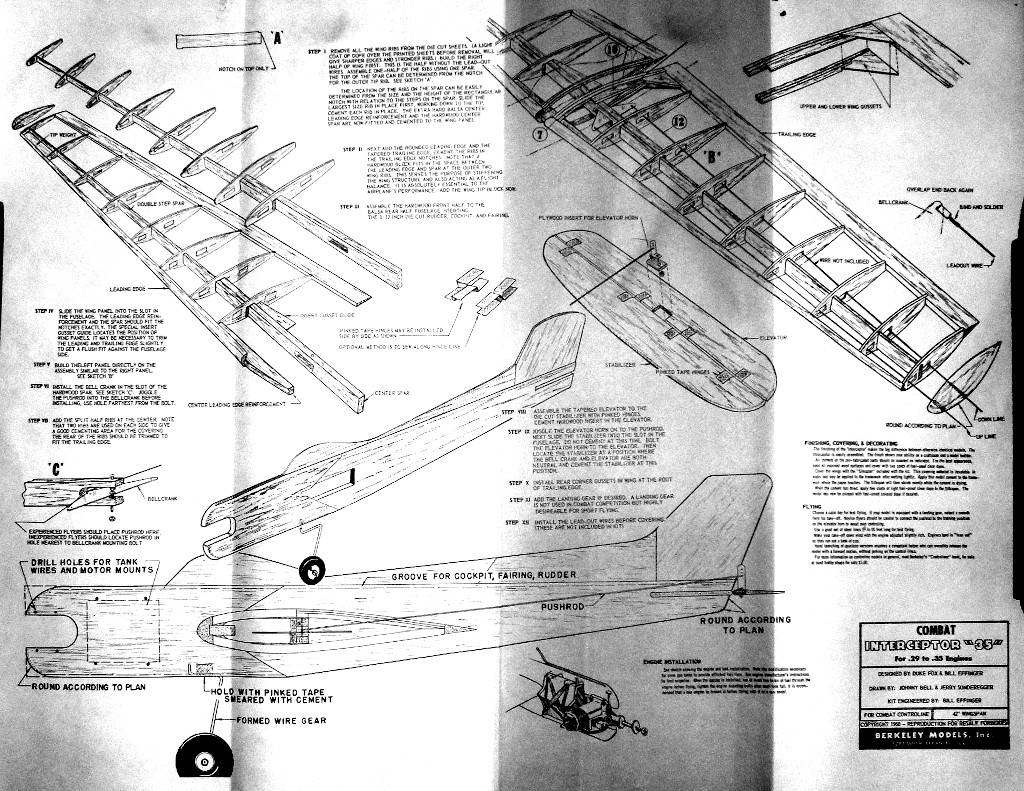
A late 1950's Model Airplane News ad:
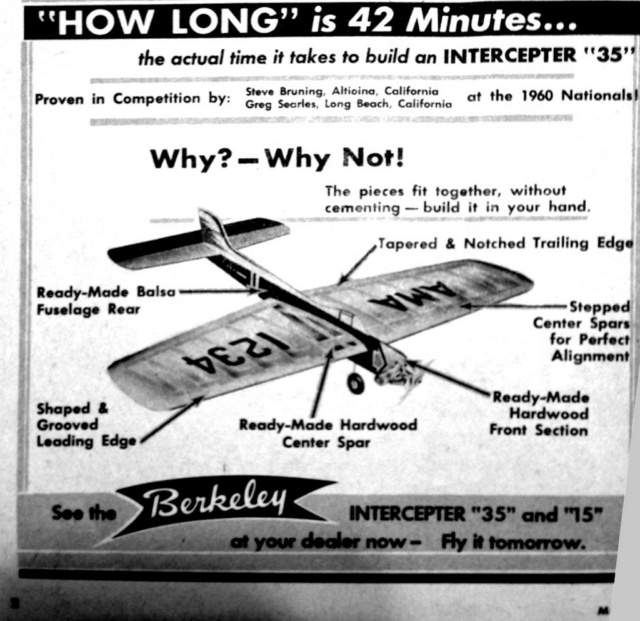
Although the plan says that it was designed by Duke Fox, it seems to have hallmarks of being an Effinger design. From what I understand (and I could be wrong, SIG finally wound up with all the Berkeley plans, some later becoming their master series scale light planes for FF/RC/CL), Duke later regretted inviting Effinger, who faced bankruptcy? and investing money and space, to move Effinger's Berkeley production from New York to Fort Smith, Arkansas.

GallopingGhostler- Top Poster


Posts : 5721
Join date : 2013-07-13
Age : 70
Location : Clovis NM or NFL KC Chiefs
 Re: K&B .35 Stallion Acquisition
Re: K&B .35 Stallion Acquisition
George, at vintage combat last September we had the Lancer and the Interceptor. I believe they were built by Jim Vagani of New Jersey. I will say that the finishes on these two planes were so outstanding it was utterly amazing. I think Jim is using the Klass Kote epoxy. I will say they looked like glass. The wings were Polyspan with the clear iron on covering over it, all striping was under the iron on and this was just jaw dropping. I'm not certain if they were kits or scratch built but it was neat to see them and pretty wild to watch them fly.

Ken Cook- Top Poster

- Posts : 5635
Join date : 2012-03-27
Location : pennsylvania
 Re: K&B .35 Stallion Acquisition
Re: K&B .35 Stallion Acquisition
Ken, I would love to see photos of those, glad to hear that someone has taken on the Intercept to complete and fly. Are there photos posted anywhere?

GallopingGhostler- Top Poster


Posts : 5721
Join date : 2013-07-13
Age : 70
Location : Clovis NM or NFL KC Chiefs
 Re: K&B .35 Stallion Acquisition
Re: K&B .35 Stallion Acquisition
Got another unloved Stallion .35 engine, with the plastic venturi insert. (Bob understands "unloved" engines.)  I bought this a couple years ago, intending to disassemble and clean it up. It is a clean engine, apparently a hardly run engine because the mount holes are very clean, may be was bench tested only, and very little testing at that. Exterior hardly displays any Castor slobber. The needle valve on the opposite side is still a bright brass with every so light tarnish.
I bought this a couple years ago, intending to disassemble and clean it up. It is a clean engine, apparently a hardly run engine because the mount holes are very clean, may be was bench tested only, and very little testing at that. Exterior hardly displays any Castor slobber. The needle valve on the opposite side is still a bright brass with every so light tarnish. 
The slotted filister head screws does show some sign of handling, but are relatively clean otherwise. This one has SPI, hmmm. I rotate the crank, and sure enough, the previous owner had installed both the cylinder liner and piston backwards. What I am seeing is the intake porting through the exhaust port.
I rotate the crank, and sure enough, the previous owner had installed both the cylinder liner and piston backwards. What I am seeing is the intake porting through the exhaust port. 
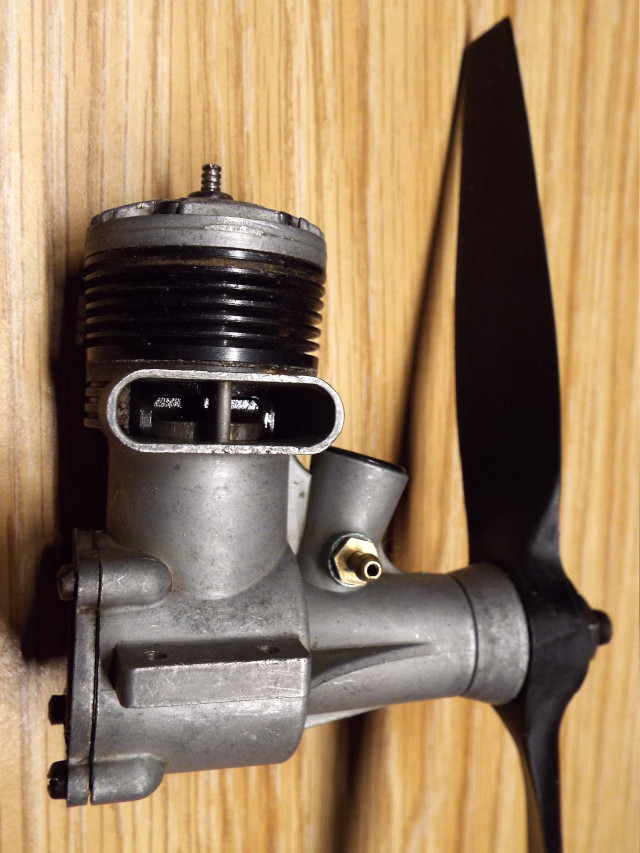
Piston head fence is near exhaust outlet, should be toward inlet.
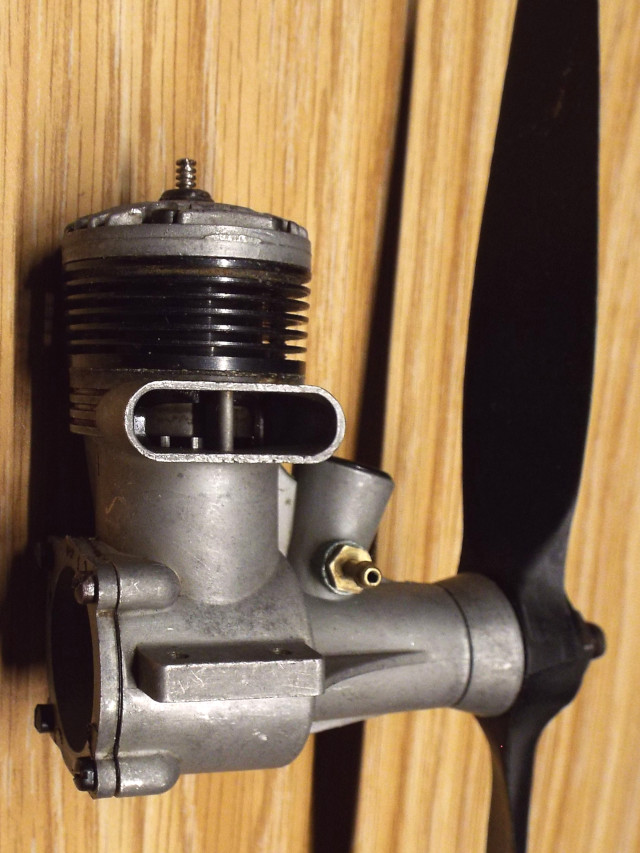
Piston skirt shows, cylinder is reversed 180 degrees.
Because this one is so clean, a good going over the exterior with solvent and reversing the cylinder liner and piston should turn it into a runner.

The slotted filister head screws does show some sign of handling, but are relatively clean otherwise. This one has SPI, hmmm.

Piston head fence is near exhaust outlet, should be toward inlet.

Piston skirt shows, cylinder is reversed 180 degrees.
Because this one is so clean, a good going over the exterior with solvent and reversing the cylinder liner and piston should turn it into a runner.


GallopingGhostler- Top Poster


Posts : 5721
Join date : 2013-07-13
Age : 70
Location : Clovis NM or NFL KC Chiefs
 Re: K&B .35 Stallion Acquisition
Re: K&B .35 Stallion Acquisition
Shot some sewing machine oil into the openings, rotated the crank several dozen times to get all internal moving surfaces lubricated and initial drag of old oil diluted and moving. Then broke out the proper sized screw driver, removed head and back screws. Back shows only a slight amount of polish from the nylon crank throw spacer fit in the hollow crankshaft con rod pin. This engine is very low time. It is also an earlier version than the other I described earlier in this thread, which had an encounter with water moisture and resulting corrosion. It resembles the one in Peter Chinn's Sept. 1964 Model Airplane News engine review, with the thin web in the exhaust port.
http://sceptreflight.com/Model%20Engine%20Tests/K&B%20Stallion%2035.html
The other (1974) has a thicker vertical web in the exhaust port that was used also for R/C, they machined a bolt hole and mounted a rotating baffle plate for idle back pressure.
Took a pocket knife blade, carefully wedged it between the aluminum head and steel finned cylinder. With a light tapping on the blade all around, the head broke free and peeled off. A light tapping on the cylinder bottom at the intake bypass and other side alternating with a blade screwdriver as the drift and small hammer through the crankcase rear, it finally broke free and slid out.
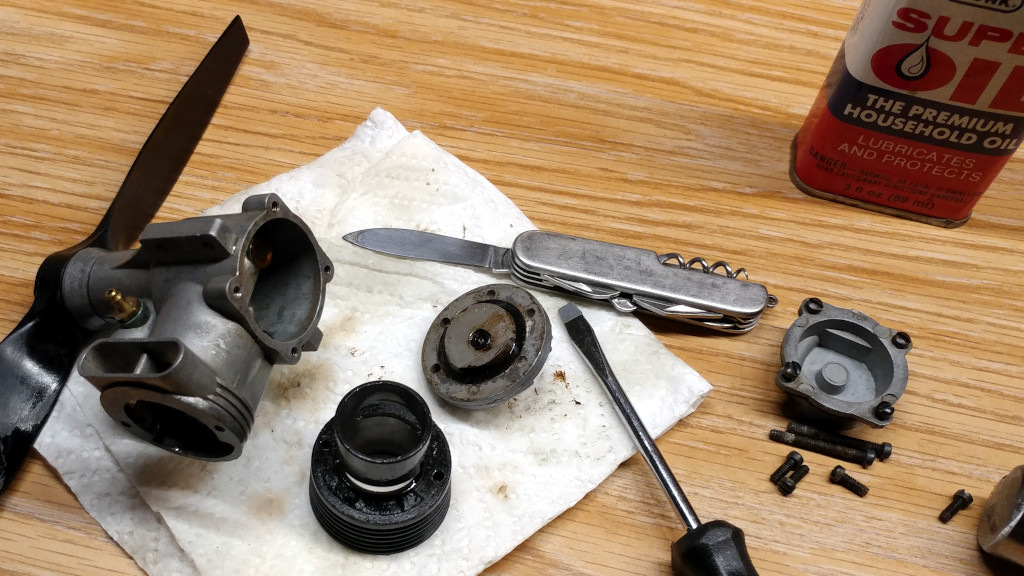
The paper head gasket is intact and usable. I'll have to make a new cylinder to crankcase gasket. This one has only 1/3rd of the original one, doesn't go around the whole cylinder. Fortunately I won't have to soak and scrub this one. It is very clean otherwise through and through.
It's late enough now, more work to follow ...

http://sceptreflight.com/Model%20Engine%20Tests/K&B%20Stallion%2035.html
The other (1974) has a thicker vertical web in the exhaust port that was used also for R/C, they machined a bolt hole and mounted a rotating baffle plate for idle back pressure.
Took a pocket knife blade, carefully wedged it between the aluminum head and steel finned cylinder. With a light tapping on the blade all around, the head broke free and peeled off. A light tapping on the cylinder bottom at the intake bypass and other side alternating with a blade screwdriver as the drift and small hammer through the crankcase rear, it finally broke free and slid out.

The paper head gasket is intact and usable. I'll have to make a new cylinder to crankcase gasket. This one has only 1/3rd of the original one, doesn't go around the whole cylinder. Fortunately I won't have to soak and scrub this one. It is very clean otherwise through and through.
It's late enough now, more work to follow ...



GallopingGhostler- Top Poster


Posts : 5721
Join date : 2013-07-13
Age : 70
Location : Clovis NM or NFL KC Chiefs
 Re: K&B .35 Stallion Acquisition
Re: K&B .35 Stallion Acquisition
That's the best way to find them George. Someone's mess-up is to your advantage. It means that the engine may have never really been run. Owner gave up, not realising that the problem was an easy fix. Whether it was a factory mix-up or an unskilled owner, a quick reassembly the correct way around can bring satisfying results.GallopingGhostler wrote:
..... This one has SPI, hmmm.I rotate the crank, and sure enough, the previous owner had installed both the cylinder liner and piston backwards. What I am seeing is the intake porting through the exhaust port.

Rod.

Oldenginerod- Top Poster

- Posts : 4018
Join date : 2012-06-15
Age : 62
Location : Drouin, Victoria
 Re: K&B .35 Stallion Acquisition
Re: K&B .35 Stallion Acquisition
The K&B Stallion was the first .35 sized engine I ever flown. It was on a Midwest P-63 Kingcobra. I still have that plane and I just recently received the engine back. I have the red , white and black box it came with as well. I don't understand why K&B used a picture of the Torpedo rear rotor .40 on the cover. Seeing that this engine was low in the line and designed to compete with others, I assume it was probably for cost reasons. I know later versions of the Stallion were produced in the familiar orange , white and purple boxes that had the K&B logo on them. The engines were sold with either polished cases or matte finish bead blasted cases, once again I would think it was a cost issue therefore polished cases were no longer used.

Ken Cook- Top Poster

- Posts : 5635
Join date : 2012-03-27
Location : pennsylvania
 Re: K&B .35 Stallion Acquisition
Re: K&B .35 Stallion Acquisition
Good looking engine George and a fix with a light cleaning should get you in running order 


getback- Top Poster



Posts : 10437
Join date : 2013-01-18
Age : 67
Location : julian , NC
 Re: K&B .35 Stallion Acquisition
Re: K&B .35 Stallion Acquisition
Nice work on the old engine George…. A good feeling to get it back in running order… My only experience with K & B was 3.5 boat engines…. Quite stout but would break cranks after a while

rdw777- Diamond Member




Posts : 1714
Join date : 2021-03-11
Location : West Texas
 Re: K&B .35 Stallion Acquisition
Re: K&B .35 Stallion Acquisition
Thanks Rod, Ken, Eric, and Robert.  It is missing the ratchet spring for the needle, but I can use one from one of my McCoy parts engines.
It is missing the ratchet spring for the needle, but I can use one from one of my McCoy parts engines.  Robert, breaking cranks, eh?
Robert, breaking cranks, eh?  You mean to tell me that we don't have a tendency to run engines to their limits?
You mean to tell me that we don't have a tendency to run engines to their limits? 
As Bob @rsv1cox says, these are just like eating Lays Potato Chips, you just can't have one. I have another, this time an R/C version. It is missing the exhaust baffle plate for non-muffled idle, but is easily rectified.
I have another, this time an R/C version. It is missing the exhaust baffle plate for non-muffled idle, but is easily rectified.
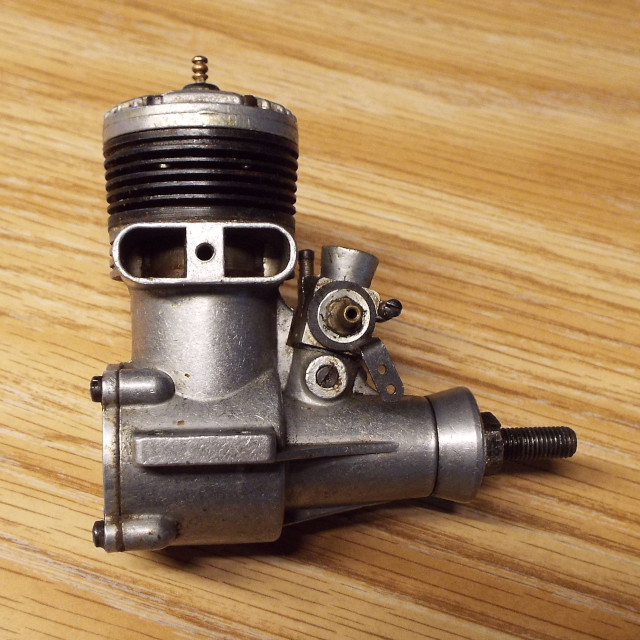
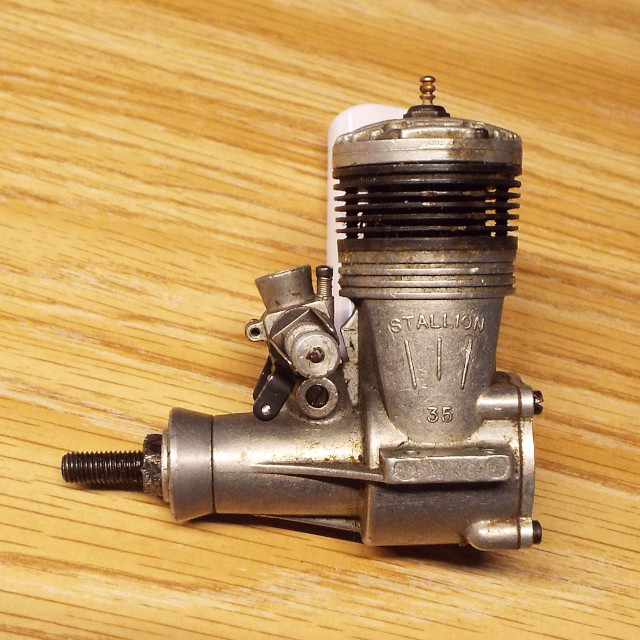

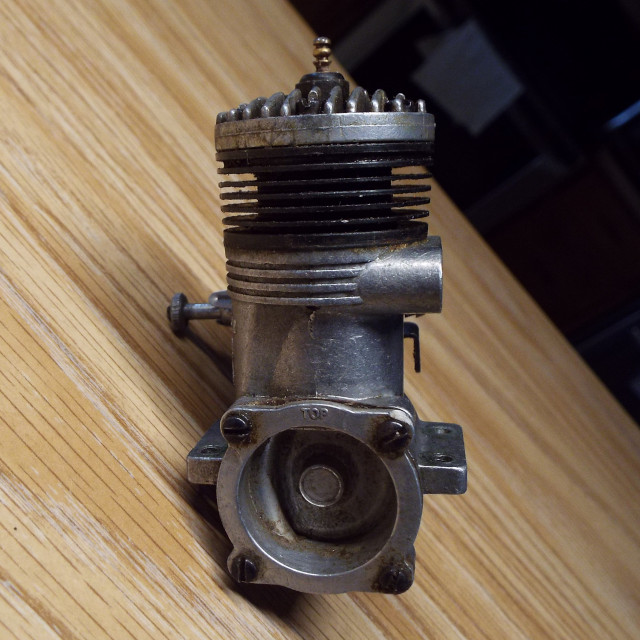

This one is broken in, but does not appear to have a lot of run time on it, has decent compression. It too, doesn't need disassembly, just a good exterior clean up. I'll pull off the back though, to make sure the nylon crank throw spacer rivet is in good condition. Just like the McCoy's, it is fitted inside the hollow crank con rod pin, to buffer the crank pin from scuffing the aluminum backplate. Also, it is missing the prop washer, as Ken pointed out with my .09 Torpedo, these came with a really nice tapered and blued steel washer. But, all in all, one from a McCoy .35 RH should work.





 Robert, breaking cranks, eh?
Robert, breaking cranks, eh? As Bob @rsv1cox says, these are just like eating Lays Potato Chips, you just can't have one.





This one is broken in, but does not appear to have a lot of run time on it, has decent compression. It too, doesn't need disassembly, just a good exterior clean up. I'll pull off the back though, to make sure the nylon crank throw spacer rivet is in good condition. Just like the McCoy's, it is fitted inside the hollow crank con rod pin, to buffer the crank pin from scuffing the aluminum backplate. Also, it is missing the prop washer, as Ken pointed out with my .09 Torpedo, these came with a really nice tapered and blued steel washer. But, all in all, one from a McCoy .35 RH should work.






GallopingGhostler- Top Poster


Posts : 5721
Join date : 2013-07-13
Age : 70
Location : Clovis NM or NFL KC Chiefs
 Re: K&B .35 Stallion Acquisition
Re: K&B .35 Stallion Acquisition
Knowing that K&B was in the market for a competitive engine, the two competitors Fox, Mccoy were producing their versions of the .35 in the 7 oz. range. The K&B is 8 3/4 oz. or very close to that. I'm not certain as to why they didn't try and aim for a lighter engine. To some, not a big deal but to some of the commercially available profiles of the period, that's a big weight difference. Larger planes in my opinion would benefit from this engine.
The Midwest series warbirds at the time were the largest wingspan planes offered. Unfortunately, the wings had very narrow airfoils. The K&B also has a different run compared to most baffled piston engines of this size. It runs in a fairly fast 2 and it doesn't change much when the nose is pointed up. I also feel it doesn't prefer 6 pitch props like the competition generally does. I know I feel the K&B benefits from 5 pitch props and keep the rpm's up. I don't think that most recognized this as a good thing back then. Most felt if they didn't hear that audible break in engine speed that the engine wasn't producing power. One needs to really experience this in a back to back comparison but the engine certainly is different than the rest.
The Midwest series warbirds at the time were the largest wingspan planes offered. Unfortunately, the wings had very narrow airfoils. The K&B also has a different run compared to most baffled piston engines of this size. It runs in a fairly fast 2 and it doesn't change much when the nose is pointed up. I also feel it doesn't prefer 6 pitch props like the competition generally does. I know I feel the K&B benefits from 5 pitch props and keep the rpm's up. I don't think that most recognized this as a good thing back then. Most felt if they didn't hear that audible break in engine speed that the engine wasn't producing power. One needs to really experience this in a back to back comparison but the engine certainly is different than the rest.

Ken Cook- Top Poster

- Posts : 5635
Join date : 2012-03-27
Location : pennsylvania
 Re: K&B .35 Stallion Acquisition
Re: K&B .35 Stallion Acquisition
Ken, you hit the mark. Sceptre Flight engine articles list the Stallion at 8.8 oz. The McCoy Red Head is 7.25, lightning version is 7.56 oz. Fox 3 bolt back is 6.4 oz., 4 bolt 7.5 oz. Perhaps the Fox 3 bolt back being a touch lighter helped popularize it with some in stunt contests.Ken Cook wrote:Knowing that K&B was in the market for a competitive engine, the two competitors Fox, Mccoy were producing their versions of the .35 in the 7 oz. range. The K&B is 8 3/4 oz. or very close to that.
Side by side, the Stallion crankcase has a much beefier nose shaft reflected in its larger diameter crankshaft. I guess that K&B was targeting the neophyte, engine was intended to sustain crash damage. Although both the McCoy and Stallion have the same backplate bolt pattern at 1" on centers and mount beam end width, the Stallion sides are radiused making a wider fuselage bearer spacing required whereas the McCoy has flat sides. It appears to require 1/8th inch more width. I remember Ken, you saying that this made the planes then dedicated to this engine as you couldn't substitute other engines without seriously re-altering the mount area. I'd need to take caliper readings on the engine mount bolt spacing, but it does appear the likelihood one could install a Red Head in the Stallion's foot print. Fox and other engines is another story.
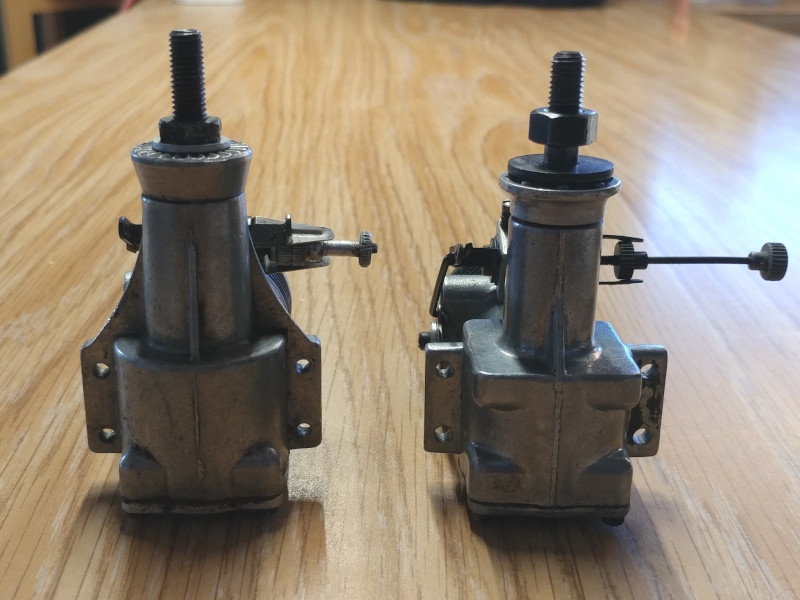
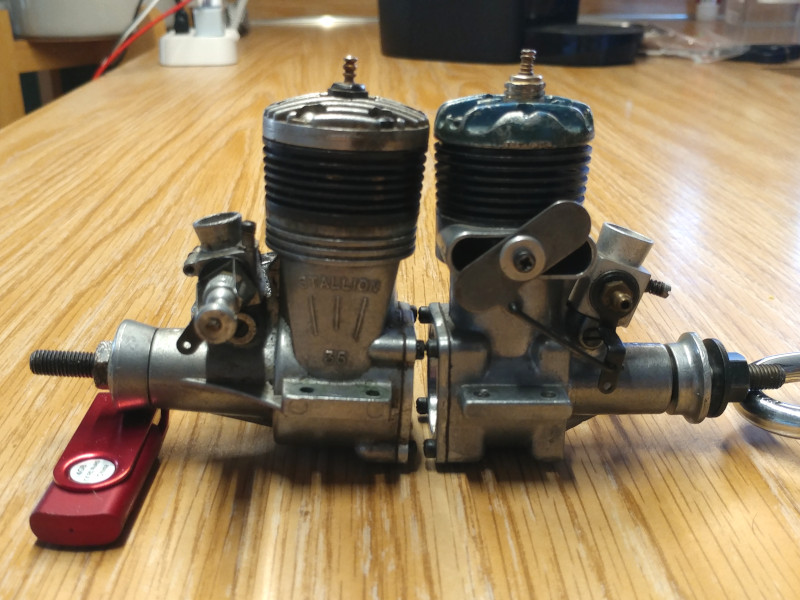
After, Testors made a huge mistake by going to a heavier crankcase design with the Series 21, the .35 at 9.6 oz. is even heavier than the Stallion. I gather sales wise the Series 21 was a total flop. Back in 1974, I bought 6 Series 21 engines from the Hickham AFB Hobby Sales Store heavily discounted on clearance (a couple times, based on multiple red tag price stickers placed over each other!) for around $6 apiece in various sizes, .19, .29, .35, .40. My brother did similar. I gathered that you couldn't give away these engines, as unpopular as they were. Apparently none of the modelers were buying. (On the air base, there still seemed to be a good number flying C/L, as the base had a couple dedicated C/L circles clearly marked for C/L flying only. Back in the late 1960's to early 1970's, in high school and when I returned to the islands being stationed there, I'd periodically go and watch them fly stunt. Some were extremely good at it.)
As is, it may work with biplanes with a shorter nose. I have an unbuilt Brodak profile Cardinal kit. Would have to shorten the fuselage at least 1.5" to 2" to make the preferred balance point CG. (I'd like to use my Series 21 .40 on this plane.)
Ken, you bring up an interesting point. Then it would be better to use them on the planes with about 500 sq. in. wing area and not use them on the smaller 400 sq. in. planes like the S-1 Ringmaster and Flite Streak.Ken Cook wrote:I'm not certain as to why they didn't try and aim for a lighter engine. To some, not a big deal but to some of the commercially available profiles of the period, that's a big weight difference. Larger planes in my opinion would benefit from this engine.
Good advice, Ken. Wasn't the slightly thinner airfoil intended for slow combat, to give the planes a slight speed advantage being less draggy? I gather they benefit from slightly longer line lengths for being slightly quicker. I did notice that the original Midwest designer came out with an unkitted redesign of the P-63, calling it the P-39, posted in a modeling magazine. He went with a standard thicker stunt airfoil and did away with wing flaps. It was said to fly just fine on elevator.Ken Cook wrote:The Midwest series warbirds at the time were the largest wingspan planes offered. Unfortunately, the wings had very narrow airfoils. The K&B also has a different run compared to most baffled piston engines of this size. It runs in a fairly fast 2 and it doesn't change much when the nose is pointed up. I also feel it doesn't prefer 6 pitch props like the competition generally does. I know I feel the K&B benefits from 5 pitch props and keep the rpm's up. I don't think that most recognized this as a good thing back then. Most felt if they didn't hear that audible break in engine speed that the engine wasn't producing power. One needs to really experience this in a back to back comparison but the engine certainly is different than the rest.

GallopingGhostler- Top Poster


Posts : 5721
Join date : 2013-07-13
Age : 70
Location : Clovis NM or NFL KC Chiefs
 Re: K&B .35 Stallion Acquisition
Re: K&B .35 Stallion Acquisition
Coming along nicely George, Nice to see these old engines given new life and see what their special use may be….
If you don’t mind me chasing a rabbit on your thread, But hopefully a bit in context….
Have any of you guys ever used the Johnson engines?…. A friend gave me a .35 in high school….. Was my first “big” engine and pulled a Ringmaster around with authority….. Started and handled really well too….Don’t hear much about them even in vintage discussions….Just curious…
If you don’t mind me chasing a rabbit on your thread, But hopefully a bit in context….
Have any of you guys ever used the Johnson engines?…. A friend gave me a .35 in high school….. Was my first “big” engine and pulled a Ringmaster around with authority….. Started and handled really well too….Don’t hear much about them even in vintage discussions….Just curious…

rdw777- Diamond Member




Posts : 1714
Join date : 2021-03-11
Location : West Texas
 Re: K&B .35 Stallion Acquisition
Re: K&B .35 Stallion Acquisition
Robert, I have no experience with the Johnson engines. I have though read positive comments about them. Occasionally they come up in auctions, on Stunt Hangar for sale. Prices more or less seem reasonable (although that may change, seems to be a lot of speculating on engines in E-Bay lately. Some people are commanding ridiculously high prices for common vintage engines).
I just haven't jumped on them, because I more or less now have more engines than I'd ever use. And, especially after I hit 65 a couple years ago, I've slowed down a lot. I get one small thing done, and now I feel good about it. Before, nothing would stop me.
Back in the old days, houses had outdoor porches, some screened in to keep out the mosquitoes. One had a pocket knife, would whittle away on a dead tree branch with the knife and chew the fat. I feel I am there now.






I just haven't jumped on them, because I more or less now have more engines than I'd ever use. And, especially after I hit 65 a couple years ago, I've slowed down a lot. I get one small thing done, and now I feel good about it. Before, nothing would stop me.
Back in the old days, houses had outdoor porches, some screened in to keep out the mosquitoes. One had a pocket knife, would whittle away on a dead tree branch with the knife and chew the fat. I feel I am there now.







GallopingGhostler- Top Poster


Posts : 5721
Join date : 2013-07-13
Age : 70
Location : Clovis NM or NFL KC Chiefs
 Re: K&B .35 Stallion Acquisition
Re: K&B .35 Stallion Acquisition
Thanks for the reply George, But you’re skeer’in me just a little!!! I’ll be 65 soon LOL!!!
Merry Christmas Compadre


Merry Christmas Compadre




rdw777- Diamond Member




Posts : 1714
Join date : 2021-03-11
Location : West Texas
 Re: K&B .35 Stallion Acquisition
Re: K&B .35 Stallion Acquisition
George, I'm a HUGE fan of the Flite Streak, all of them. The K&B Stallion would be a perfect match here. I say this for a few reasons. The Flite Streak has a very thick airfoil compared to a Ringmaster and this is a bit more draggy but it flies like a dream. In addition, the nose is short on the Streak so a bit more weight certainly isn't going to impact it like it would on a Ringmaster. Another model that comes to mind would be the Dumas Tomahawk. This is not to be confused with a Brodak or Veco Tomahawk. This plane could easily be mistaken for a Flite Streak with the exception of it's tail feathers which are swept and the corners clipped. It too has a short nose and I've used the Stallion on this model with very good success. The K&B wants to run and it wants to run in the upper rpm range and stay there so keeping the speed up works well for the engine and the Streak.
Now that you mentioned the beefier case, I remember a ad for this engine substantiating what you said in regards to crashing. This is the reason for the replaceable threaded shaft in the front of the crank. I will say this, if that shaft on the Stallion breaks, one better get a new hobby. That is a serious blocky shaft counterweight and thickness. The Fox on the other hand is susceptible to breaking and I've had about 3 failures in the shaft entirely breaking and at least 3 more where the crankpin has sheared off. I think once the crappy rod stretches out on the big end it hammers the pin.
As for Johnson engines, I know a few guys who use the combat Johnson .36's. Johnson made the pistons for Mccoy engines which seems odd. The Johnson pistons last while the Mccoy seems to disintegrate. They were expensive engines back in the day and they fetch a fair amount of money today. I always liked the name Stunt Supreme for the .35 and I believe they made a .32. The engine I'm most familiar with is the Johnson .36 combat special. I've never owned any variant of a Johnson.
What I find ironic many times is the involvement of certain individuals with the engines we like so much. Hi -Johnson had roots with many manufacturers like Veco and Orwick and Bob Holland. It amazes me that so many engines have connections back to several manufacturers we all know.
George another thing I meant to mention above is the footprint of the Stallion. Many times you can have Fox .35's and while they're all essentially the same, the bolt pattern seems to alter sometimes from one to another. This is a little true for the Mccoy as well. While almost every Mccoy interchanges with itself, some of the versions have the slotted holes. This is very close to the Stallion, almost identical and it will work but it all depends on how close the bearers were placed. Seeing the Mccoy case is square, it's a lot easier to get the bearers close to the case whereas the Stallion has the radius. Many times, on a profile, I pad the engine off of the body using phenolic spacers.
Now that you mentioned the beefier case, I remember a ad for this engine substantiating what you said in regards to crashing. This is the reason for the replaceable threaded shaft in the front of the crank. I will say this, if that shaft on the Stallion breaks, one better get a new hobby. That is a serious blocky shaft counterweight and thickness. The Fox on the other hand is susceptible to breaking and I've had about 3 failures in the shaft entirely breaking and at least 3 more where the crankpin has sheared off. I think once the crappy rod stretches out on the big end it hammers the pin.
As for Johnson engines, I know a few guys who use the combat Johnson .36's. Johnson made the pistons for Mccoy engines which seems odd. The Johnson pistons last while the Mccoy seems to disintegrate. They were expensive engines back in the day and they fetch a fair amount of money today. I always liked the name Stunt Supreme for the .35 and I believe they made a .32. The engine I'm most familiar with is the Johnson .36 combat special. I've never owned any variant of a Johnson.
What I find ironic many times is the involvement of certain individuals with the engines we like so much. Hi -Johnson had roots with many manufacturers like Veco and Orwick and Bob Holland. It amazes me that so many engines have connections back to several manufacturers we all know.
George another thing I meant to mention above is the footprint of the Stallion. Many times you can have Fox .35's and while they're all essentially the same, the bolt pattern seems to alter sometimes from one to another. This is a little true for the Mccoy as well. While almost every Mccoy interchanges with itself, some of the versions have the slotted holes. This is very close to the Stallion, almost identical and it will work but it all depends on how close the bearers were placed. Seeing the Mccoy case is square, it's a lot easier to get the bearers close to the case whereas the Stallion has the radius. Many times, on a profile, I pad the engine off of the body using phenolic spacers.

Ken Cook- Top Poster

- Posts : 5635
Join date : 2012-03-27
Location : pennsylvania
 Re: K&B .35 Stallion Acquisition
Re: K&B .35 Stallion Acquisition
Thanks, Ken for your inputs.  Robert, facts of life, didn't mean to spook you.
Robert, facts of life, didn't mean to spook you. 

Ken, it is good that you mention that the proportions of the Flite Streak are ideal for this engine. I was planning to use the engine in my Berkeley Interceptor 35, because it has similar proportions to the Flite Streak, even the thicker wing and shorter nose.

Here's the great quality of a Berkeley Intercept fuselage. Red oak solid fuselage front butt joined to balsa without ply side bridging them. I'll redo this, may be even make a whole new fuselage, because I don't know how long it would stay together.


However, Berkeley's designer had some strange ideas on how the wing should interface with the fuselage, basically having a rectangular cut out for the leading edge to spar. Trailing edge was butt glued to fuselage side, instead of building the wing whole first, and sliding it into an airfoil shaped slot. Then of course it has the great quality Berkeley balsa wood and plywood (the cuts the other manufacturers rejected). Says it goes together in 42 minutes, probably falls apart in the same amount of time, too.
Says it goes together in 42 minutes, probably falls apart in the same amount of time, too. 
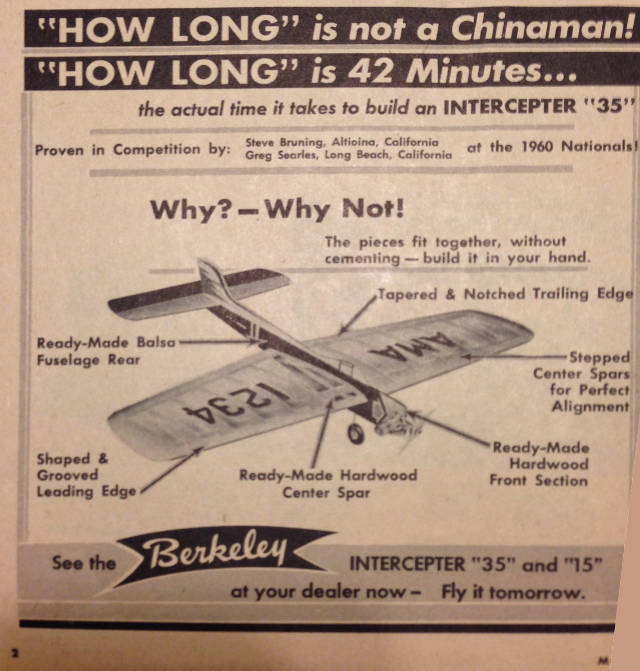
A statement like that nowadays would drive the woke totally bonkers!
 (and I am half Oriental)
(and I am half Oriental) 
Made a new cylinder to crankcase gasket out of the thin cardboard from a Ritz Crackers box flap. When I removed the fragment of a gasket, found there was the original gasket underneath it. Don't know what a previous owner was trying to do.

Perhaps this is why the engine doesn't do a regular 4-cycle to 2-cycle transition? K&B efficiency at its best, at TDC, the air-fuel mixture is almost completely emptied into the combustion side of the cylinder head.

Engine is now together again. It has like new compression, and as Rod suspected, hardly run, is stiff and somewhat draggy like a new, unbroken in engine.
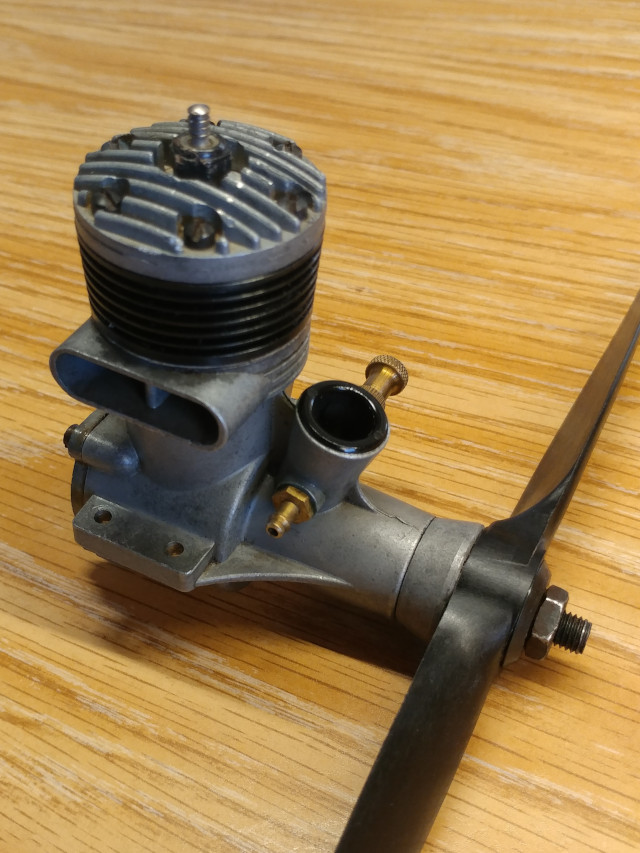
I'll have to redo the backplate gasket. It seeps the light machine oil that I put in for lubrication.
 Robert, facts of life, didn't mean to spook you.
Robert, facts of life, didn't mean to spook you. 

Ken, it is good that you mention that the proportions of the Flite Streak are ideal for this engine. I was planning to use the engine in my Berkeley Interceptor 35, because it has similar proportions to the Flite Streak, even the thicker wing and shorter nose.

Here's the great quality of a Berkeley Intercept fuselage. Red oak solid fuselage front butt joined to balsa without ply side bridging them. I'll redo this, may be even make a whole new fuselage, because I don't know how long it would stay together.


However, Berkeley's designer had some strange ideas on how the wing should interface with the fuselage, basically having a rectangular cut out for the leading edge to spar. Trailing edge was butt glued to fuselage side, instead of building the wing whole first, and sliding it into an airfoil shaped slot. Then of course it has the great quality Berkeley balsa wood and plywood (the cuts the other manufacturers rejected).
 Says it goes together in 42 minutes, probably falls apart in the same amount of time, too.
Says it goes together in 42 minutes, probably falls apart in the same amount of time, too. 

A statement like that nowadays would drive the woke totally bonkers!
 (and I am half Oriental)
(and I am half Oriental) Made a new cylinder to crankcase gasket out of the thin cardboard from a Ritz Crackers box flap. When I removed the fragment of a gasket, found there was the original gasket underneath it. Don't know what a previous owner was trying to do.

Perhaps this is why the engine doesn't do a regular 4-cycle to 2-cycle transition? K&B efficiency at its best, at TDC, the air-fuel mixture is almost completely emptied into the combustion side of the cylinder head.

Engine is now together again. It has like new compression, and as Rod suspected, hardly run, is stiff and somewhat draggy like a new, unbroken in engine.

I'll have to redo the backplate gasket. It seeps the light machine oil that I put in for lubrication.

GallopingGhostler- Top Poster


Posts : 5721
Join date : 2013-07-13
Age : 70
Location : Clovis NM or NFL KC Chiefs
Page 3 of 4 •  1, 2, 3, 4
1, 2, 3, 4 
Page 3 of 4
Permissions in this forum:
You cannot reply to topics in this forum

 Rules
Rules







